 Black Panther #1 — Writer: Ta-Nehisi Coates; Art: Brian Stelfreeze; Colors: Laura Martin
Black Panther #1 — Writer: Ta-Nehisi Coates; Art: Brian Stelfreeze; Colors: Laura Martin
Spider-Women Alpha #1 — Writer: Robbie Thompson; Art: Vanesa Del Ray; Colors: Jordie Bellaire
Poe Dameron #1 — Writer: Charles Soule; Art/Colors: Phil Noto
Amadeus Cho: Genius at Work #1 (of 1) — Writers: Greg Pak and Fred van Lente; Art: Takeshi Miyazawa, Gary Frank and Rodney Buchemi
Of all the Marvel first issues this week, none has been more anticipated than Black Panther, partly because the company tapped as writer Ta-Nehisi Coates, a prominent author on African-American issues (among other topics), who last year won both a MacArthur Fellowship and a National Book Award for Non-fiction and, even more importantly for fans, is a major comics geek. Add to that their selection of Brian Stelfreeze, an artist with a sleek, design-oriented style, and interest in 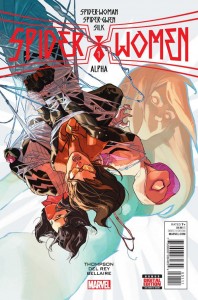 the comic has been high. So, how is it? The good news is that Coates has crafted a layered, smart, densely-political story that pays tribute to all of the Panther’s past exploits, and looks at his tenuous grip as leader of a fractured Wakandan nation. The bad news is… that doesn’t necessarily play well as the debut issue of a new comics series: there’s little overt superhero action to attract readers who don’t already know a lot about the character. Thanks to Stelfreeze, it looks great, and as the first chapter of a graphic novel it’ll be fine, but will it bring back casual fans who just picked up the first floppy issue on a whim? That’s not to say it’s a bad story — I liked it a lot, but then I’ve been reading Panther comics since the Don McGregor/Billy Graham ’70s — but there’s nothing here to make a brand-new reader go “Wow, so that’s why the Black Panther is a cool character.” Let’s just hope Marvel’s committed to at least 12 issues of this, so it has time to get a couple of trade collections out, find its natural audience there, and sell enough to justify keeping the monthly version around too. Spider-Women Alpha is the starting-point bookend to a crossover
the comic has been high. So, how is it? The good news is that Coates has crafted a layered, smart, densely-political story that pays tribute to all of the Panther’s past exploits, and looks at his tenuous grip as leader of a fractured Wakandan nation. The bad news is… that doesn’t necessarily play well as the debut issue of a new comics series: there’s little overt superhero action to attract readers who don’t already know a lot about the character. Thanks to Stelfreeze, it looks great, and as the first chapter of a graphic novel it’ll be fine, but will it bring back casual fans who just picked up the first floppy issue on a whim? That’s not to say it’s a bad story — I liked it a lot, but then I’ve been reading Panther comics since the Don McGregor/Billy Graham ’70s — but there’s nothing here to make a brand-new reader go “Wow, so that’s why the Black Panther is a cool character.” Let’s just hope Marvel’s committed to at least 12 issues of this, so it has time to get a couple of trade collections out, find its natural audience there, and sell enough to justify keeping the monthly version around too. Spider-Women Alpha is the starting-point bookend to a crossover  through the Spider-Woman, Silk and Spider-Gwen books, wherein the three friends get together for an arachnid-girls’-night-out over in Gwen’s universe and get trapped there; it’s got interesting semi-impressionistic art by Del Ray, while Thompson, who’s written all three characters in the past, has their voices down well. Whether fans of the individual titles will be thrilled at spending the next two months with a crossover is another question, but at least it’s a “family” one, with some thematic connection between the titles, instead of some company-wide juggernaut (*cough* Civil War II *cough*). Poe Dameron is exactly what you think it is: a before-the-movie adventure of the hotshot Star Wars pilot and his rotund little droid; Soule and Noto have worked on the SW books before, so they know how to deliver a good story — although the plot here could have involved Hans Solo and R2-D2 and been pretty much the same thing. The Amadeus Cho is a reprint collection of appearances of that
through the Spider-Woman, Silk and Spider-Gwen books, wherein the three friends get together for an arachnid-girls’-night-out over in Gwen’s universe and get trapped there; it’s got interesting semi-impressionistic art by Del Ray, while Thompson, who’s written all three characters in the past, has their voices down well. Whether fans of the individual titles will be thrilled at spending the next two months with a crossover is another question, but at least it’s a “family” one, with some thematic connection between the titles, instead of some company-wide juggernaut (*cough* Civil War II *cough*). Poe Dameron is exactly what you think it is: a before-the-movie adventure of the hotshot Star Wars pilot and his rotund little droid; Soule and Noto have worked on the SW books before, so they know how to deliver a good story — although the plot here could have involved Hans Solo and R2-D2 and been pretty much the same thing. The Amadeus Cho is a reprint collection of appearances of that 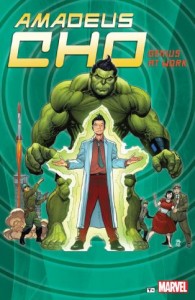 character, who’s starring as the new Hulk; it’s got his first appearance, in Amazing Fantasy #15 (no, not that one; the much more obscure other one, from 2006), Hulk #100 (from the “Planet Hulk” storyline, where he becomes the green guy’s associate), and a quartet of stories from Incredible Hercules (#126, 133, 135 and 137) that detail his origins. Six comics for the $7.99 cover price isn’t bad (those Hercules issues are probably over at our discount hub for 99 cents, but the Amazing Fantasy is around $50 right now, and the Hulk‘s around $6); if you want to see how his creator, Greg Pak, handled him before he became all green and drawn by Frank “no relation” Cho, this is a good way to do it.
character, who’s starring as the new Hulk; it’s got his first appearance, in Amazing Fantasy #15 (no, not that one; the much more obscure other one, from 2006), Hulk #100 (from the “Planet Hulk” storyline, where he becomes the green guy’s associate), and a quartet of stories from Incredible Hercules (#126, 133, 135 and 137) that detail his origins. Six comics for the $7.99 cover price isn’t bad (those Hercules issues are probably over at our discount hub for 99 cents, but the Amazing Fantasy is around $50 right now, and the Hulk‘s around $6); if you want to see how his creator, Greg Pak, handled him before he became all green and drawn by Frank “no relation” Cho, this is a good way to do it.
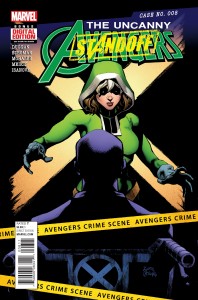 The Uncanny Avengers #8 — Writer: Gerry Duggan; Pencils: Ryan Stegman; Inks: Mark Morales, Dave Meikis and Ryan Stegman; Colors: Richard Isanove
The Uncanny Avengers #8 — Writer: Gerry Duggan; Pencils: Ryan Stegman; Inks: Mark Morales, Dave Meikis and Ryan Stegman; Colors: Richard Isanove
The New Avengers #9 — Writer: Al Ewing; Art: Marcus To; Colors: Dono Sanchez Almara
Two more installments of the Avengers: Standoff: Assault on Pleasant Hill crossover; they aren’t particularly connected, so it doesn’t really matter what order they’re read in. Uncanny finds members of that team, and of the All-New, All-Different Avengers, trapped in the titular small town with their memories erased, courtesy of a sentient cosmic cube; most of the book involves one of them figuring out what’s going on, and gradually awakening the others. There are a couple of good bits (Deadpool really doesn’t like Connecticut…), but 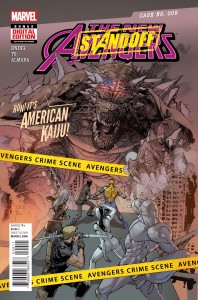 it’s mostly smooth, decent-looking space-filler. New Avengers has that team, headquartered on A.I.M. Island, being attacked by the US military for having broken Rick Jones out of a S.H.I.E.L.D. installation. One of the US soldiers has been transformed into a giant Godzilla-like monster (the “American Kaiju” mentioned on the cover), and watching him stomp around the island yelling “USA! USA!” is kind of fun; if you’re a manga fan you won’t be a bit surprised that our heroes have developed a big giant Avengers robot for just such occasions. Despite being part of the crossover, this never gets to Pleasant Hill at all, which is actually in its favor; regular readers can enjoy it without feeling too much disruption of the continuity.
it’s mostly smooth, decent-looking space-filler. New Avengers has that team, headquartered on A.I.M. Island, being attacked by the US military for having broken Rick Jones out of a S.H.I.E.L.D. installation. One of the US soldiers has been transformed into a giant Godzilla-like monster (the “American Kaiju” mentioned on the cover), and watching him stomp around the island yelling “USA! USA!” is kind of fun; if you’re a manga fan you won’t be a bit surprised that our heroes have developed a big giant Avengers robot for just such occasions. Despite being part of the crossover, this never gets to Pleasant Hill at all, which is actually in its favor; regular readers can enjoy it without feeling too much disruption of the continuity.
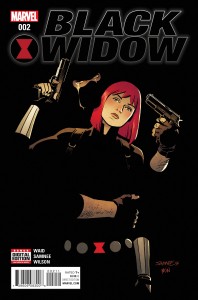 Black Widow #2 — Writers: Chris Samnee and Mark Waid; Art: Chris Samnee; Colors: Matthew Wilson
Black Widow #2 — Writers: Chris Samnee and Mark Waid; Art: Chris Samnee; Colors: Matthew Wilson
Scarlet Witch #5 — Writer: James Robinson; Art: Javier Pulido; Colors: Muntsa Vicente
Spider-Man #3 — Writer: Brian Michael Bendis; Art: Sara Pichelli; Colors: Justin Ponsor
Invincible Iron Man #8 — Writer: Brian Michael Bendis; Art: Mike Deodato; Colors: Frank Martin
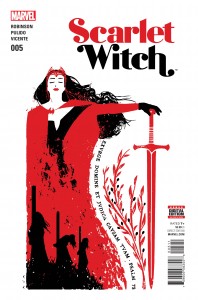 The Infinity Entity #4 (of 4) — Writer: Jim Starlin; Pencils: Alan Davis; Inks: Mark Farmer; Colors: Wil Quintana
The Infinity Entity #4 (of 4) — Writer: Jim Starlin; Pencils: Alan Davis; Inks: Mark Farmer; Colors: Wil Quintana
The Vision #6 — Writer: Tom King; Art: Gabriel Hernandez Walta; Colors: Jordie Bellaire
The other Marvels for the week: Black Widow, after its whip-fast, near-silent first issue, fills in how Natasha got to the point of robbing something from the S.H.I.E.L.D. helicarrier; blackmail seems a trifle too pat, but since this is a spy story, and Waid always maxes out his genres, I think we’ll end up seeing triple and quadruple-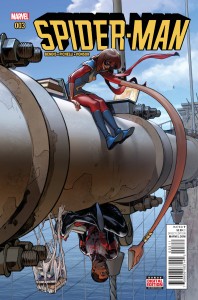 crosses before this story’s finished, so it’s best not to take anything at face value yet. Samnee, who’s credited as both artist and co-writer, makes it all gorgeous (shadowy cemetaries have never looked this good), and Wilson’s coloring is a perfect match. A very similar visual combination is going on over in Scarlet Witch, where the great Javier Pulido, who spent most of last year making She-Hulk look really good, draws a one-shot tale involving a monastery haunted by ghosts from the Spanish Inquisition (unexpected, I know…); the plot requires most of the story to be silent, and the art, in its precise layout and intricate design, is stunning. Muntsa Vicente, who colored those She-Hulk books, knows exactly how to use bold hues and contrasts to
crosses before this story’s finished, so it’s best not to take anything at face value yet. Samnee, who’s credited as both artist and co-writer, makes it all gorgeous (shadowy cemetaries have never looked this good), and Wilson’s coloring is a perfect match. A very similar visual combination is going on over in Scarlet Witch, where the great Javier Pulido, who spent most of last year making She-Hulk look really good, draws a one-shot tale involving a monastery haunted by ghosts from the Spanish Inquisition (unexpected, I know…); the plot requires most of the story to be silent, and the art, in its precise layout and intricate design, is stunning. Muntsa Vicente, who colored those She-Hulk books, knows exactly how to use bold hues and contrasts to 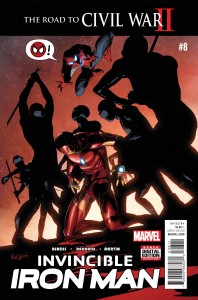 bring out every nuance of Pulido’s art; between them, Black Widow and Scarlet Witch are two of the best-looking comics published so far this year. Spider-Man, too, has luck in its art, since Sara Pichelli, who’s been drawing Miles Morales and his cast for years, is very good at combining shady realism (for gangster types like Hammerhead), good-looking people, and subtle comedy (Miles’s grandmother, a Hispanic spitfire, has taken over the Morales household, convinced that her grandson is in the grip of “the drugs,” and watching him struggle with being grounded (with the help of Ms. Marvel, who knows something about super-strict parental units) is a lot of fun, just the kind of amusing soap-opera-with-
bring out every nuance of Pulido’s art; between them, Black Widow and Scarlet Witch are two of the best-looking comics published so far this year. Spider-Man, too, has luck in its art, since Sara Pichelli, who’s been drawing Miles Morales and his cast for years, is very good at combining shady realism (for gangster types like Hammerhead), good-looking people, and subtle comedy (Miles’s grandmother, a Hispanic spitfire, has taken over the Morales household, convinced that her grandson is in the grip of “the drugs,” and watching him struggle with being grounded (with the help of Ms. Marvel, who knows something about super-strict parental units) is a lot of fun, just the kind of amusing soap-opera-with-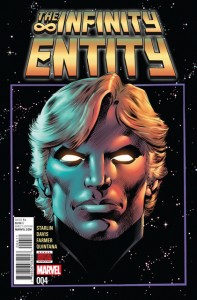 superheroes that Bendis has been using in the Ultimate Spider-Man comics for many years now. Iron Man, also by Bendis, guest-stars the Peter Parker Spider-Man, as he and Tony team up to search Tokyo for Rhodey, who’s been kidnapped by techno-ninjas (because Japan…); the dialogue and byplay among the heroes, as always, is fun, and Deodato’s another artist who makes everything look good, with his solid, shadow-tinged art — just look at that cover, if you want a free sample. Infinity Entity wraps up its short run (it’s acting as a bridge between Starlin’s original graphic novels starring Warlock,
superheroes that Bendis has been using in the Ultimate Spider-Man comics for many years now. Iron Man, also by Bendis, guest-stars the Peter Parker Spider-Man, as he and Tony team up to search Tokyo for Rhodey, who’s been kidnapped by techno-ninjas (because Japan…); the dialogue and byplay among the heroes, as always, is fun, and Deodato’s another artist who makes everything look good, with his solid, shadow-tinged art — just look at that cover, if you want a free sample. Infinity Entity wraps up its short run (it’s acting as a bridge between Starlin’s original graphic novels starring Warlock,  Thanos and the rest of his cosmic cast), with the reveal of a behind-the-scenes villain who’s both unexpected and very logical; with a scheme that helps us to understand why so many IT people seem to have made a deal with the devil. That leaves The Vision, rounding out its first arc as the Vision family gets a dog (in the absolute creepiest way possible), bonds over revealed secrets, and, on the last page, signals that its second arc will be both action-packed and apocalyptic; I think this book ties with Jem and the Holograms for the most unexpectedly-good comic of the last year or two.
Thanos and the rest of his cosmic cast), with the reveal of a behind-the-scenes villain who’s both unexpected and very logical; with a scheme that helps us to understand why so many IT people seem to have made a deal with the devil. That leaves The Vision, rounding out its first arc as the Vision family gets a dog (in the absolute creepiest way possible), bonds over revealed secrets, and, on the last page, signals that its second arc will be both action-packed and apocalyptic; I think this book ties with Jem and the Holograms for the most unexpectedly-good comic of the last year or two.
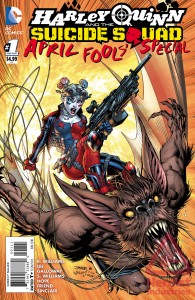 Harley Quinn and the Suicide Squad April Fools’ Special #1 (of 1) — Writer: Rob Williams; Pencils: Jim Lee; Inks: Scott Williams, Sandra Hope and Richard Friend; Colors: Alex Sinclair; Dream sequence art and colors: Sean Galloway
Harley Quinn and the Suicide Squad April Fools’ Special #1 (of 1) — Writer: Rob Williams; Pencils: Jim Lee; Inks: Scott Williams, Sandra Hope and Richard Friend; Colors: Alex Sinclair; Dream sequence art and colors: Sean Galloway
Justice League: The Darkseid War Special #1 (of 1) — Writer: Geoff Johns; Art: Ivan Reis and Joe prado, Oscar Jimenez, Paul Pelletier and Tony Kordos
Bloodlines #1 (of 6) — Writer: J. T. Krul; Pencils: V. Ken Marion; Inks: Sean Parsons; Colors: Andrew Dalhouse
DC’s first issues for the week. Harley Quinn is hardly 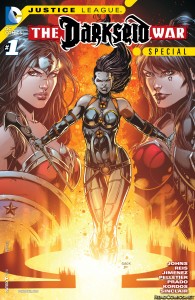 new, but books starring her are pretty much like printing money for that company right now; this stand-alone issue boasts art by Jim Lee (so we get a couple of splashes of him doing both Man-Bat and The Joker), and a long fantasy sequence where Harley becomes a psychotherapist to super-villains, with bigfoot graphics by Sean Galloway, probably best known for being the designer and artist on the Spectacular Spider-Man TV show; this comic’s a lead-in to the next volume of Suicide Squad, too, if you need any more reasons to buy it. Justice League: Darkseid War Special #1 offers another small slice of the going-on-a-year-now JL/Apocolips mashup, focusing partly on the woman who’s Power Ring fighting for control inside that sentient alien piece of jewelry, while it’s mostly the origin of Grail, the daughter of an Amazon and born the
new, but books starring her are pretty much like printing money for that company right now; this stand-alone issue boasts art by Jim Lee (so we get a couple of splashes of him doing both Man-Bat and The Joker), and a long fantasy sequence where Harley becomes a psychotherapist to super-villains, with bigfoot graphics by Sean Galloway, probably best known for being the designer and artist on the Spectacular Spider-Man TV show; this comic’s a lead-in to the next volume of Suicide Squad, too, if you need any more reasons to buy it. Justice League: Darkseid War Special #1 offers another small slice of the going-on-a-year-now JL/Apocolips mashup, focusing partly on the woman who’s Power Ring fighting for control inside that sentient alien piece of jewelry, while it’s mostly the origin of Grail, the daughter of an Amazon and born the  same day as Wonder Woman and… something something; it’s hard to keep a Geoff Johns plot straight when it’s only dribbled out every couple of months. Bloodlines is a mini-series revival of a story about spinal-fluid-sucking alien parasites who end up activating earthpeople’s metapowers; it tied together all the 1993 DC Annuals, and was a springboard for creating over 25 new characters, of which exactly one — the Garth Ennis/John McCrea Hitman — is remembered today. I don’t know whether someone figured this was a way to keep certain character names legally viable or what, but it launches with no publicity, an obscure creative team and only the sketchiest of reasons to exist.
same day as Wonder Woman and… something something; it’s hard to keep a Geoff Johns plot straight when it’s only dribbled out every couple of months. Bloodlines is a mini-series revival of a story about spinal-fluid-sucking alien parasites who end up activating earthpeople’s metapowers; it tied together all the 1993 DC Annuals, and was a springboard for creating over 25 new characters, of which exactly one — the Garth Ennis/John McCrea Hitman — is remembered today. I don’t know whether someone figured this was a way to keep certain character names legally viable or what, but it launches with no publicity, an obscure creative team and only the sketchiest of reasons to exist.
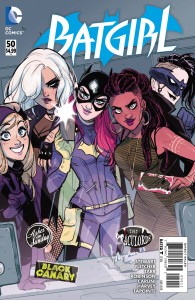 Batgirl #50 — Writers: Cameron Stewart and Brenden Fletcher; Art: Babs Tarr, Roger Robinson, John Timms, Eleonora Carlini and James Harvey; Colors: Serge Lapointe, Lee Loughridge and James Harvey
Batgirl #50 — Writers: Cameron Stewart and Brenden Fletcher; Art: Babs Tarr, Roger Robinson, John Timms, Eleonora Carlini and James Harvey; Colors: Serge Lapointe, Lee Loughridge and James Harvey
Superman: The Coming of the Supermen #3 (of 6) — Writer/Artist: Neal Adams; Ink Assists: Buzz and Josh Adams; Co0lors: Tony Avina
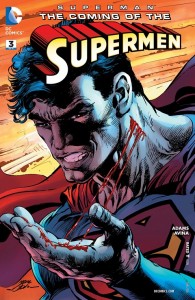 Swamp Thing #4 (of 6) — Writer: Len Wein; Art: Kelley Jones; Colors: Michelle Madsen
Swamp Thing #4 (of 6) — Writer: Len Wein; Art: Kelley Jones; Colors: Michelle Madsen
The other DCs — Batgirl is another giant-size fiftieth issue, a big fight with lots of enemies and allies that’s the culmination of the last year and a half of the title, and it’s very good, with all the characters — and artists — getting a chance to show their stuff and remind us how groundbreaking this comic has been, and how much fun, 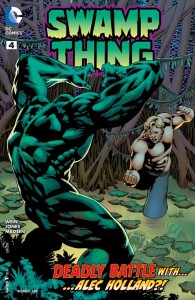 too. Coming of the Supermen is Neal Adams doing the Man of Steel, with a trio of Kryptonians helping him fight Darkseid and his minions; you have to ignore some of Adams’s weird dialogue tics, but it’s action-packed, well-plotted and very good-looking. Swamp Thing suffers from a predictable plot (Matt Cable switches with Alec Holland to become the new Swamp Thing, and it doesn’t go well. You think?), but it’s nostalgic having scripter Len Wein back on one of his signature creations after over forty years, and I could look at Kelley Jones’s horror-tinged insane-swamp-creature art all day.
too. Coming of the Supermen is Neal Adams doing the Man of Steel, with a trio of Kryptonians helping him fight Darkseid and his minions; you have to ignore some of Adams’s weird dialogue tics, but it’s action-packed, well-plotted and very good-looking. Swamp Thing suffers from a predictable plot (Matt Cable switches with Alec Holland to become the new Swamp Thing, and it doesn’t go well. You think?), but it’s nostalgic having scripter Len Wein back on one of his signature creations after over forty years, and I could look at Kelley Jones’s horror-tinged insane-swamp-creature art all day.
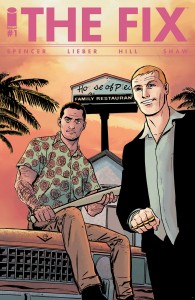 The Fix #1 — Writer: Nick Spencer; Art: Steve Leiber; Colors: Ryan Hill
The Fix #1 — Writer: Nick Spencer; Art: Steve Leiber; Colors: Ryan Hill
Empress #1 (of 7) — Writer: Mark Millar; Pencils: Stuart Immonen; Inks: Wade von Grawbadger; Colors: Ive Svorcina
The Wicked and the Divine #18 — Writer: Kieron Gillen; Art: Jamie McKelvie; Colors: Matthew Wilson
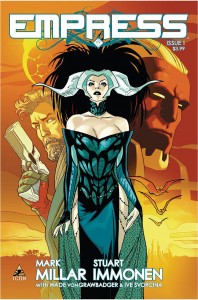 Archie #7 — Writer: Mark Waid; Art: Veronica Fish; Colors: Andre Szymanowicz with Jen Vaughn
Archie #7 — Writer: Mark Waid; Art: Veronica Fish; Colors: Andre Szymanowicz with Jen Vaughn
Rachel Rising #41 (of 42) — Creator: Terry Moore
Only five indy titles: of the debuts, The Fix is an over-the-top crooked-cop caper comic, breezy and 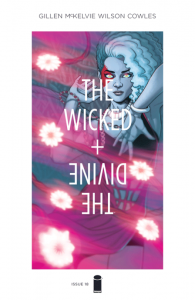 entertaining, although Nick Spencer’s attempts to do Garth Ennis gross-outs get a little old after a while, and it’s too lightweight to be memorable. Empress is the newest Mark Millar; it posits a space-faring Earth civilization co-existing with the dinosaurs 65 million years ago, with dictators and court intrigues and so on. Millar can do stories like this in his sleep, but he always snags good artists to help him, and watching Immonen and von Grawbadger have fun with all the sf settings and
entertaining, although Nick Spencer’s attempts to do Garth Ennis gross-outs get a little old after a while, and it’s too lightweight to be memorable. Empress is the newest Mark Millar; it posits a space-faring Earth civilization co-existing with the dinosaurs 65 million years ago, with dictators and court intrigues and so on. Millar can do stories like this in his sleep, but he always snags good artists to help him, and watching Immonen and von Grawbadger have fun with all the sf settings and 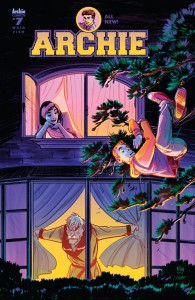 costumes should be enough to bring readers back for the rest of the series. Of the ongoing titles, The Wicked and the Divine kicks off a new arc with the return of a character we all thought was dead (there she is, right on the cover), and it’s wall-to-wall action; after the last set of episodes, with experimental storytelling and guest artists and lots of groundwork-laying, it’s refreshing to be back to just Gillen and McKelvie, charging straight ahead and blowing stuff up and beating people with sticks and generally having a blast. Archie continues its reimagination of the Riverdale wonder, although it’s not as groundbreaking as you might think: Waid’s good at
costumes should be enough to bring readers back for the rest of the series. Of the ongoing titles, The Wicked and the Divine kicks off a new arc with the return of a character we all thought was dead (there she is, right on the cover), and it’s wall-to-wall action; after the last set of episodes, with experimental storytelling and guest artists and lots of groundwork-laying, it’s refreshing to be back to just Gillen and McKelvie, charging straight ahead and blowing stuff up and beating people with sticks and generally having a blast. Archie continues its reimagination of the Riverdale wonder, although it’s not as groundbreaking as you might think: Waid’s good at 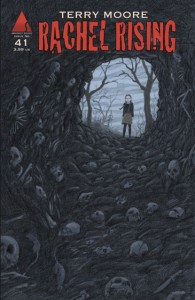 nailing the title character’s central decency and pure-heartedness, even as he’s showing him inadvertently destroying a newspaper office (in a couple of slapstick sequences that could have been drawn by Don DeCarlo), and explaining why Pop Tate is, quietly, the most powerful man in town. Rachel Rising, set to conclude next issue, makes this penultimate chapter the climax of its demon-possession Biblical-apocalypse sister-buddy horror story; Terry Moore always seems to know exactly what he’s doing, and while this cast will be missed (especially the casually-lethal little girl Zoe), it’s been a satisfying and well-told run.
nailing the title character’s central decency and pure-heartedness, even as he’s showing him inadvertently destroying a newspaper office (in a couple of slapstick sequences that could have been drawn by Don DeCarlo), and explaining why Pop Tate is, quietly, the most powerful man in town. Rachel Rising, set to conclude next issue, makes this penultimate chapter the climax of its demon-possession Biblical-apocalypse sister-buddy horror story; Terry Moore always seems to know exactly what he’s doing, and while this cast will be missed (especially the casually-lethal little girl Zoe), it’s been a satisfying and well-told run.



